Hello everyone, and welcome to this week’s URR update! It has been lovely to see all the positive feedback to the previous update, both here and on the various other sites where I post it, and I also of course appreciate the critiques, the comments, the alternative suggestions, and so on. All these things are really essential to polishing the game to the highest level I can get it, and quite a few of them have definitely given me important and consequential things to think about. This week we don’t have a single major addition like the universities from last week, and nor do we have a bug-fixing post either – although either the next one, or the one after that, will be one of those. Instead this week we have a number of smaller but important things which have been added, polished, or finished, including concluding some existing features and adding a couple of new ones. There’s some good stuff here, so without further ado, let’s get started:
Universities Part II
Last week’s main update was of course looking at universities. I talked about how the universities were generated in terms of location and name, how the actual map tile the university sits on is generated, then the main buildings we’re looking at – a great hall, classrooms, student accommodation, and any specific national religious or cultural things which should be included in a given university campus. We also looked inside some of the buildings at things like lecterns and bookcases, how libraries work, and so on. This week I’ve been doing a lot of work finishing these things off, and this had several components. Part of this has just been adding more varieties and more components to the generators shown off last time in order to maximise and guarantee their diversity and their variation – and hence the period of time before a given player will cycle back around and see the same variation twice – but I have also been adding a couple of new things to add as well.
One of these has been continuing to work on the museum. As mentioned last time, some of the things spawning in a museum will be things that consume a full tile, like a statue, and thus count as a “feature” feature in the game’s code. These cannot be picked up, but other things in the museum should instead be obscure items for around the world (which ordinarily could be picked up). However, we don’t want the player to just be able to pick all those up and rob the museum, and while I’m working on how exactly stealing and owning mechanics are going to work, we don’t want to be giving the player a huge load of stuff which they can just instantly acquire in the museum. As such, the items which spawn in museums no longer appear on tables, but instead on a new feature – the plinth. These are made out of marble and it was fun to throw together a quick little generator for these in the past couple of weeks. These cannot be moved onto, and thus one cannot move onto the tile where the item is being positioned, and thus you can’t pick it up – and instead can only look at it. This is a small addition but I’m happy with how these look, and I think they’ll fit in well with the rest of the museum aesthetic – the shape of the plinth being, of course, dependent on the shape aesthetic preference of the nation where it spawns.
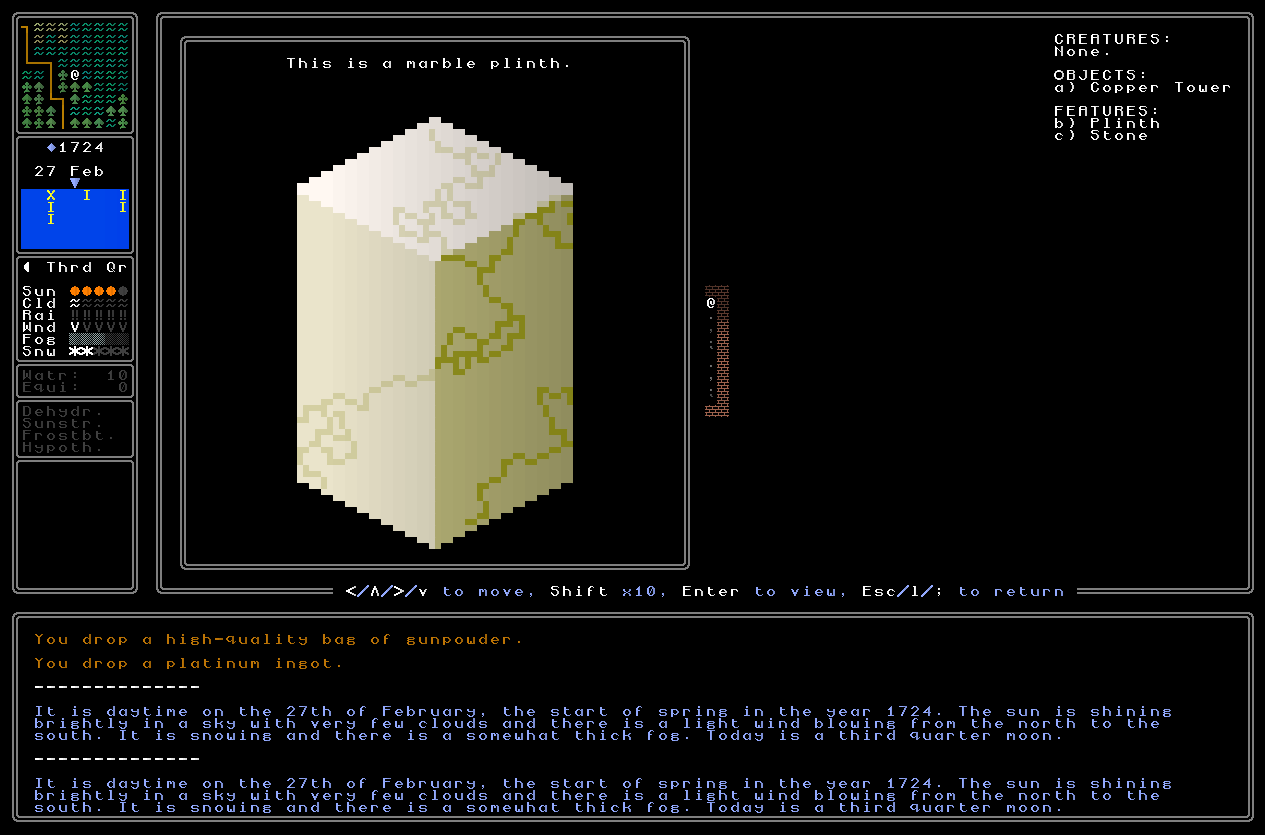
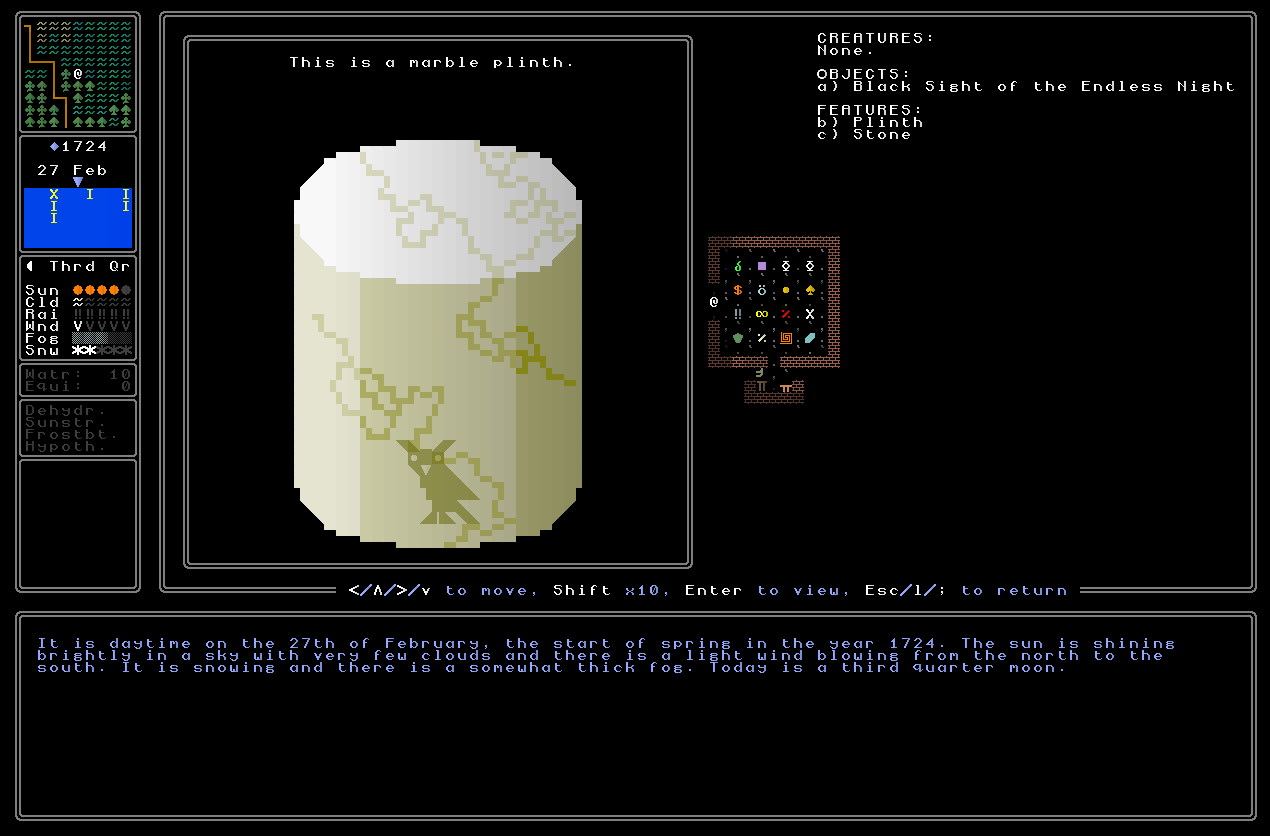
The next thing was to add another floor to the great halls. The museum is on an upper floor above the great hall itself, but I wanted to give you something underneath as well. Great halls are therefore now also spawned with basements, quite like some of the other large buildings in the game world – things like parliamentary buildings, mansions, and so on – and these contain a bunch of boxes and crates, a bunch of tables and chairs, and that’s pretty much it. As with everything, part of the goal here is to add more detail and more lived-in-ness to the world, but also as with everything else, there’s always the possibility of something important being hidden there, something which might be found there that would be of use to you later in your quest, and so on. This was also a small addition but continued to flesh out and add some more places and detail to the universities in the game, and I think these look perfectly serviceable (and of course are generated in terms of shapes, layouts, positions of tables / chairs, positions of crates, and so on).
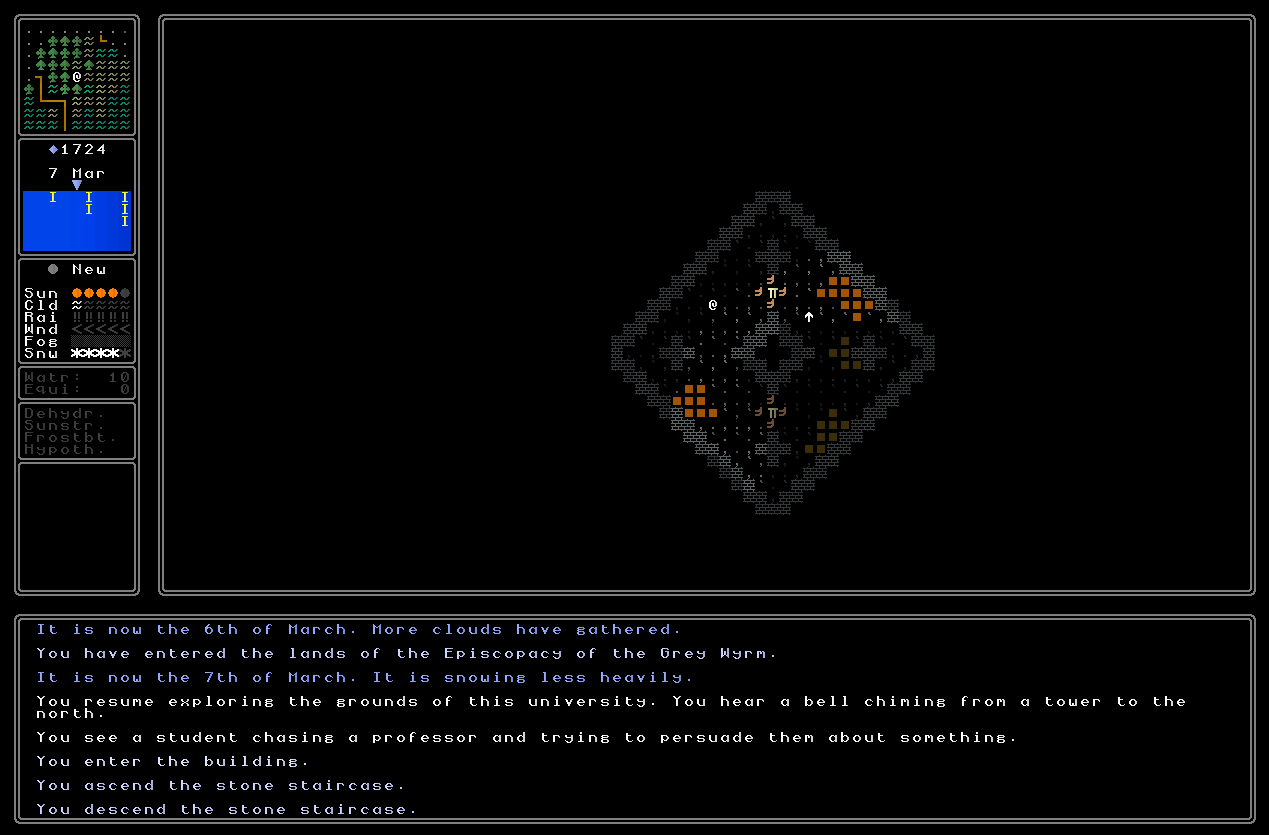
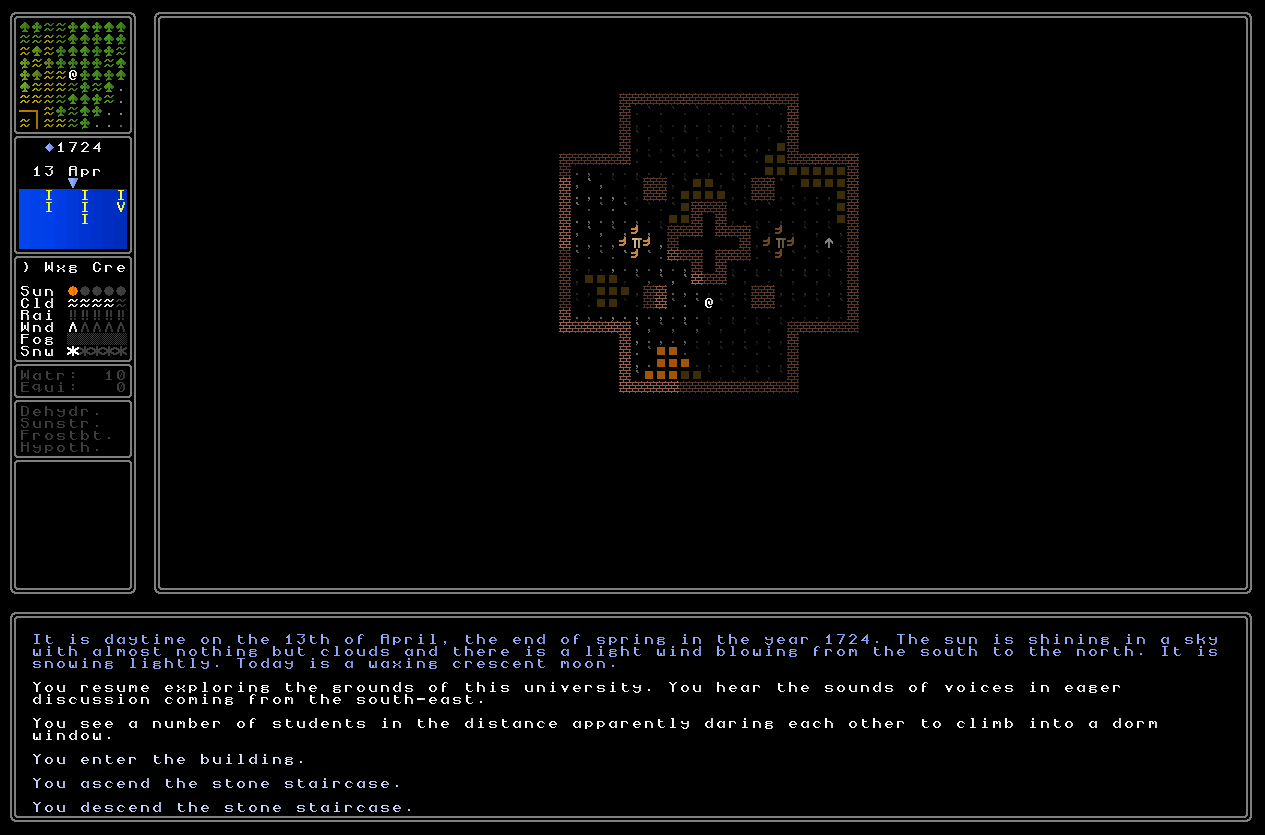
This then means that all the great halls have two staircases. Each great hall archetype or generator has a wide range of different places where the up stair to the museum and the down stair to the basement can be located, and each generation selects one of these from the larger set at random and places the stair in that location. In turn, each of the main civilization shapes has five main variations for the great hall’s ground floor, while these variations also in turn possess a number of sub-variations and aspects which differ within that variant. All of this of course goes along with other changeable elements such as the materials used to build furniture, the colours of the floor, things of this sort. The basement shapes are selected according to the aesthetic choices of that civilization, while the stuff in the museum is always stuff from outside that nation, and the shape of the museum floor is, again, a reflection of that civilization’s preferred shape. With all of this done I think we can largely call the great halls finished – we still need a bit more of the “setting” in order to explain the starting conditions, and I need to actually get the player spawning in the museum rather than spawning in the upper class district of a local city as they do now, for these are relatively minor remaining jobs. Three weeks on from the last update, I remain very happy with this starting location, and I think it’ll give a much better sense to the new player of what they’re doing, and what the game is about.
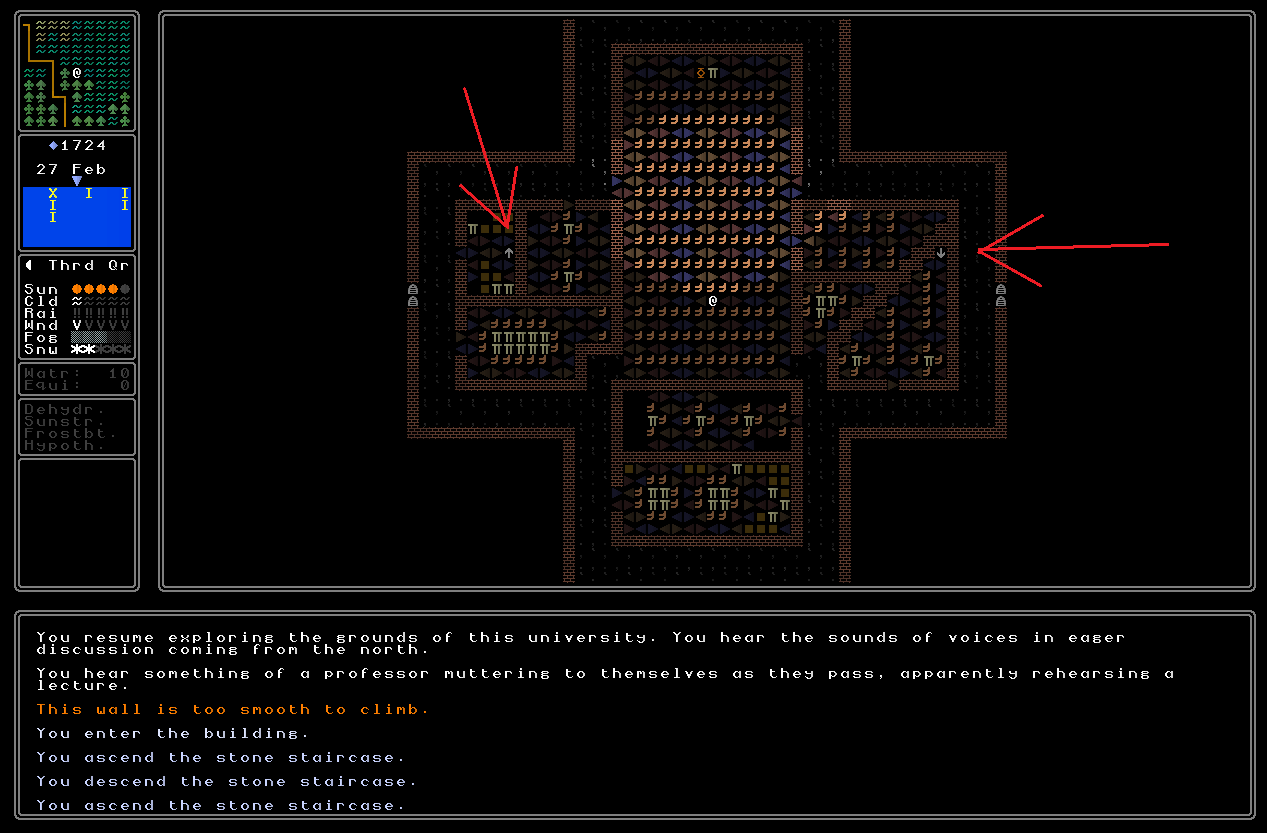
Masks Part II
A little while ago we had masks generated, but I came back to them and didn’t feel they were quite at the calibre of some of the other images I’ve been generating in the game recently, e.g….
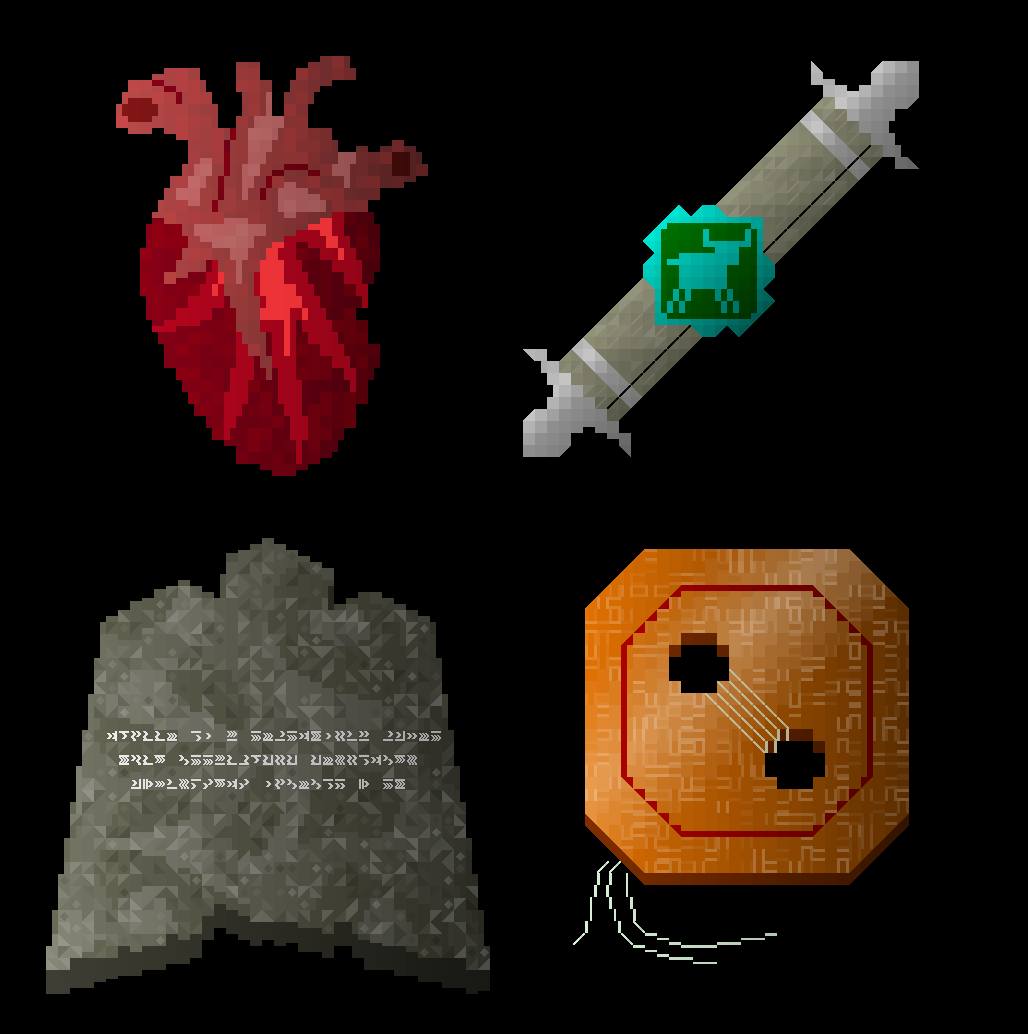
…to name just a few. Many of the masks just looked a bit too same-y, and a bit too pristine, and so I therefore decided to come back to them, really put in the time, and make some major additions to each type and their overall role in the game as well. Firstly, for all masks, I added the possibility for a large number of extra variations in terms of shape design on top of what is already there – just little extra shapes here, a bit more mask there, a little bit less mask in some other place, and so on. All of the mask shapes therefore now have a wide range of different parts of the mask which can be added or taken away, so two square masks – even if they are the same size and from the same civilization, and even of the same type – should actually wind up looking very different. This has really helped a lot with adding a sense of variation and variety, and I think the masks are looking much better for it. The other part has been adding damage effects. Masks can now be chipped or slightly damaged, and the number of chips and damage depends on the nature of the mass. As such, here are some updated mask visuals!
Here’s a cult mask…
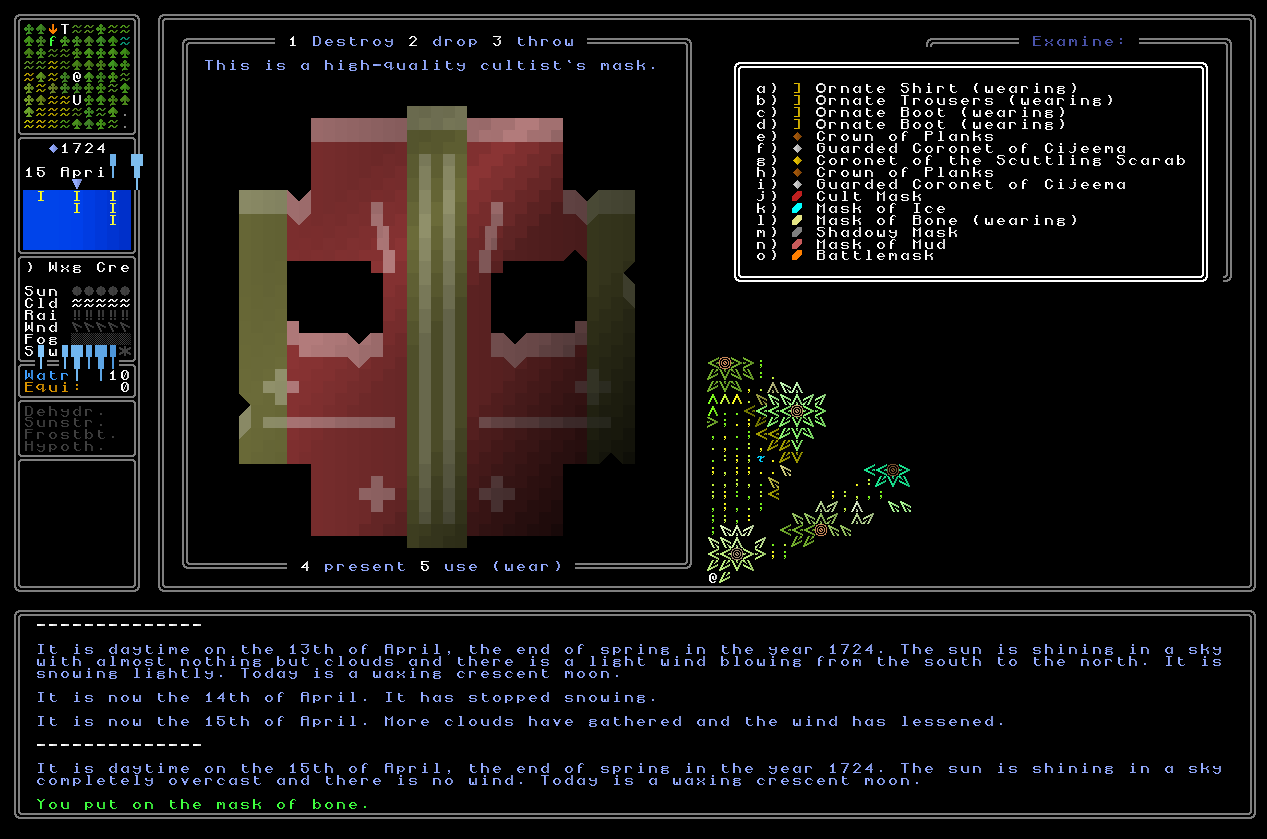
…and a bone mask, one of the three unusual materials that a civilization can choose to make its masks from:
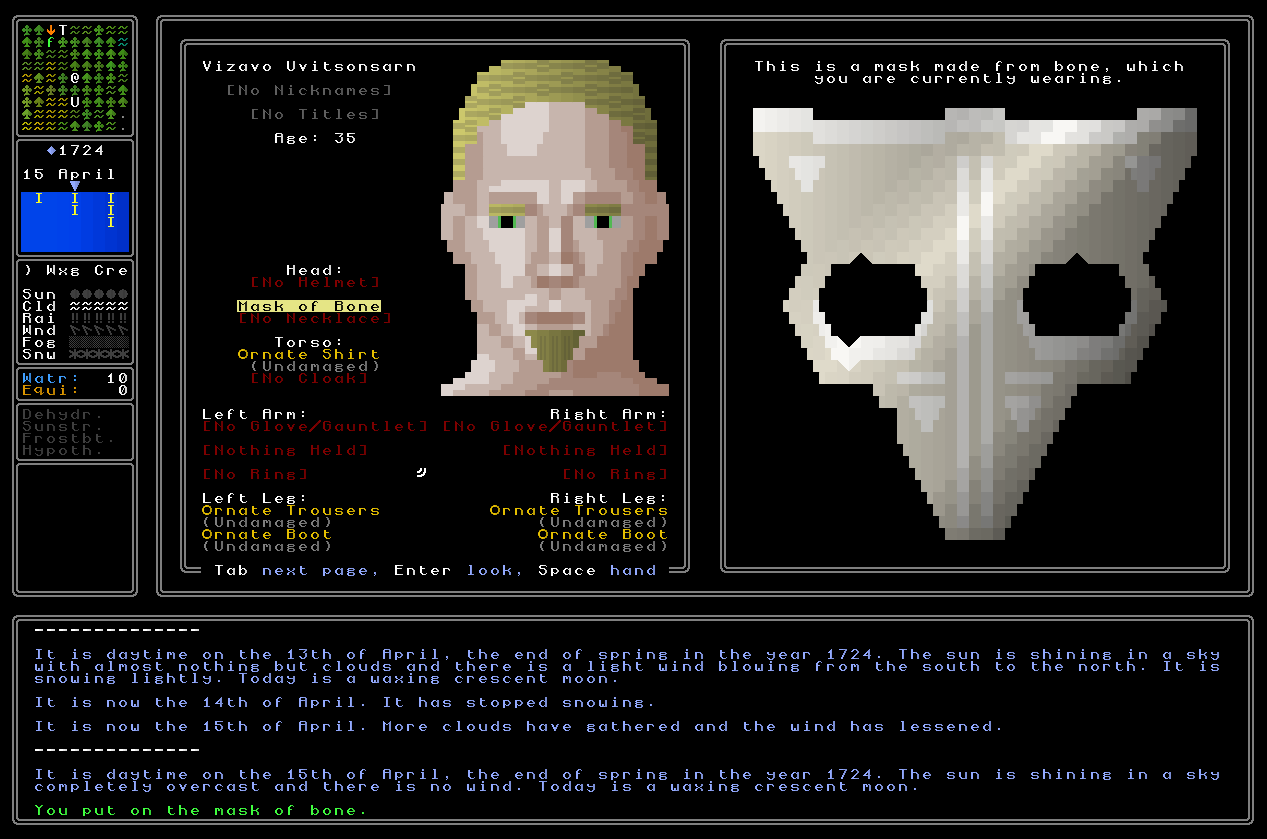
Then we have a battlemask, whose colours I’ve slightly intensified:
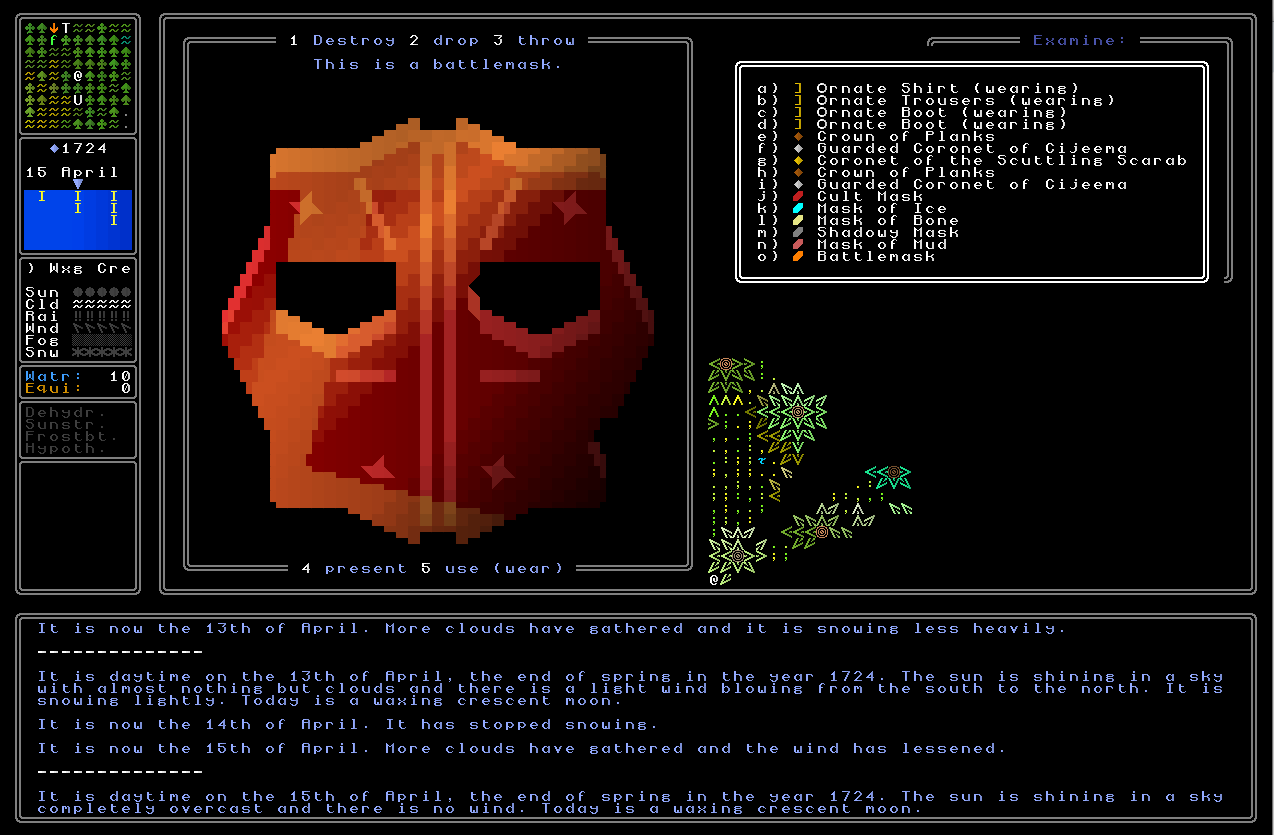
And then mud and ice masks, the other two unusual materials:
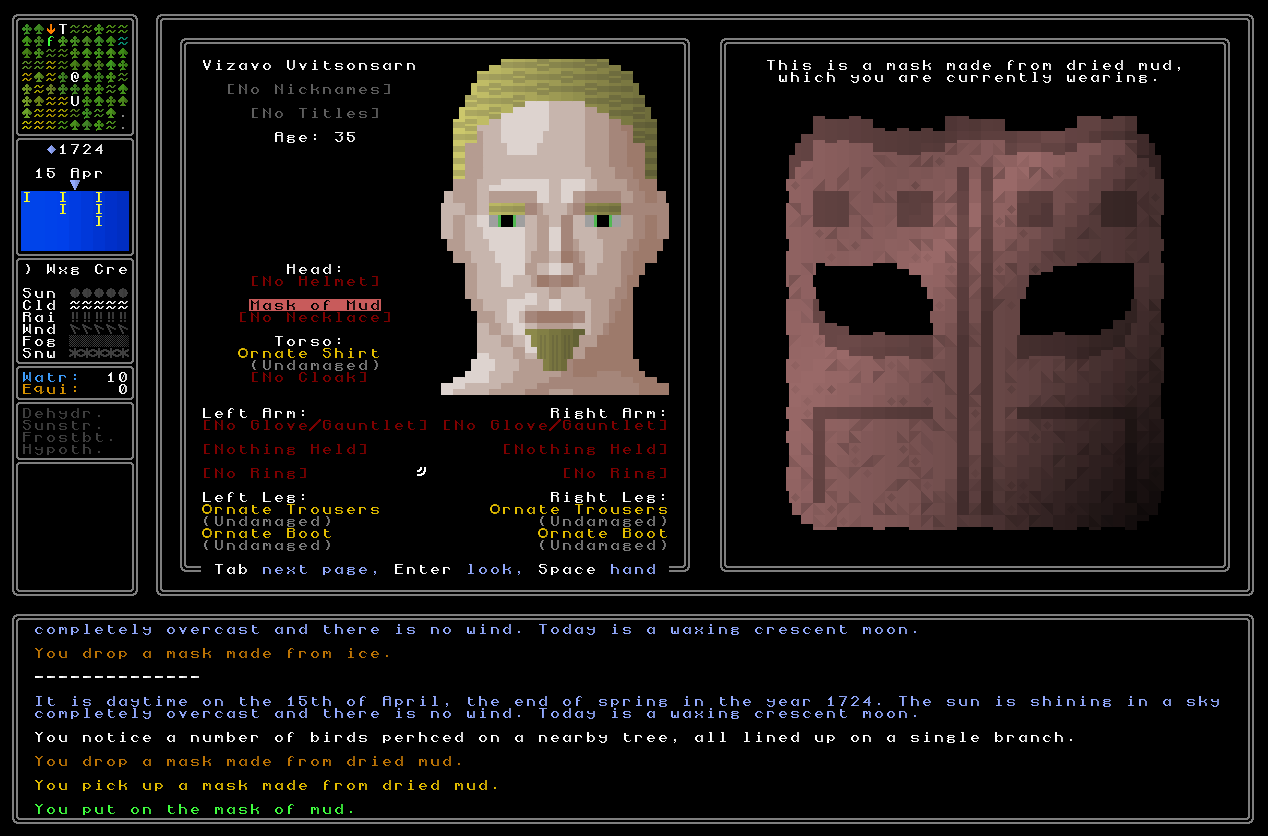
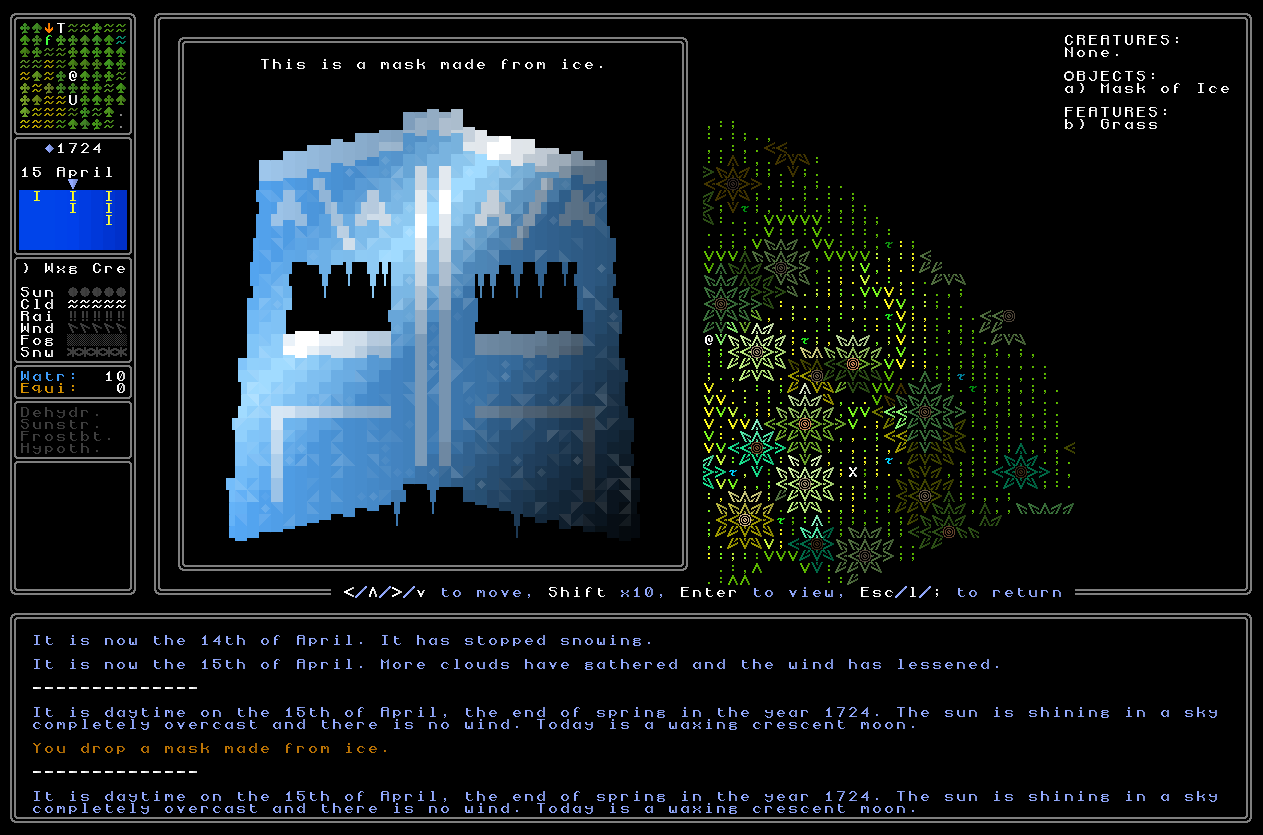
In these latter two you’ll also see a lot more detail and texture has been added compared to the previous versions. The mud mask option no longer just has a flat texture, but instead has a very wobbly and wiggly edge, and a much more detailed and speckled texture on the mask itself. The frozen mask, meanwhile, also has a partly melted and wiggly texture, and the random small icicles and drips have also been enhanced both in how they’re placed, and in their visuals. I’m confident these are now in line with the graphical quality of the rest of the game – they look a lot more physical, lot more lived in, and the amount of variation between two masks – even, as above, with extremely similar traits – has been increased by quite literally several orders of magnitude. A big improvement!
I have also added a number of new masks, however, and I think these are looking really cool. The first of these are punishment masks, either for a civilization which keeps people in prison, or a civilization which is big on the whole torture thing. As with all the other archetypes, this took a little bit of work to make sure that they were looking how I wanted them to, and adding the extra variation in how the eye sockets are shown (see below), but after some work I think these make for a really solid addition. Only one civilization will be selected in each game will to use these masks, and it will either be a “penitentiary” trait nation, or an “ordeal” trait nation. If it’s the former, then all prisoners will wear these masks during their sentences, and if it’s the latter, then people being tortured you might find in dungeons and elsewhere will wear the second type of mask. With around twenty feudal & ancient civilizations in a given world, that means between five and ten civilizations with one or the other of those policies, and only one of them will select to use masks – so again keeping it nice and rare and distinct and noteworthy when the player encounters that civilization, but also making it common enough that the player will, actually, encounter these masks from time to time. I certainly wouldn’t want to wear one of these myself!
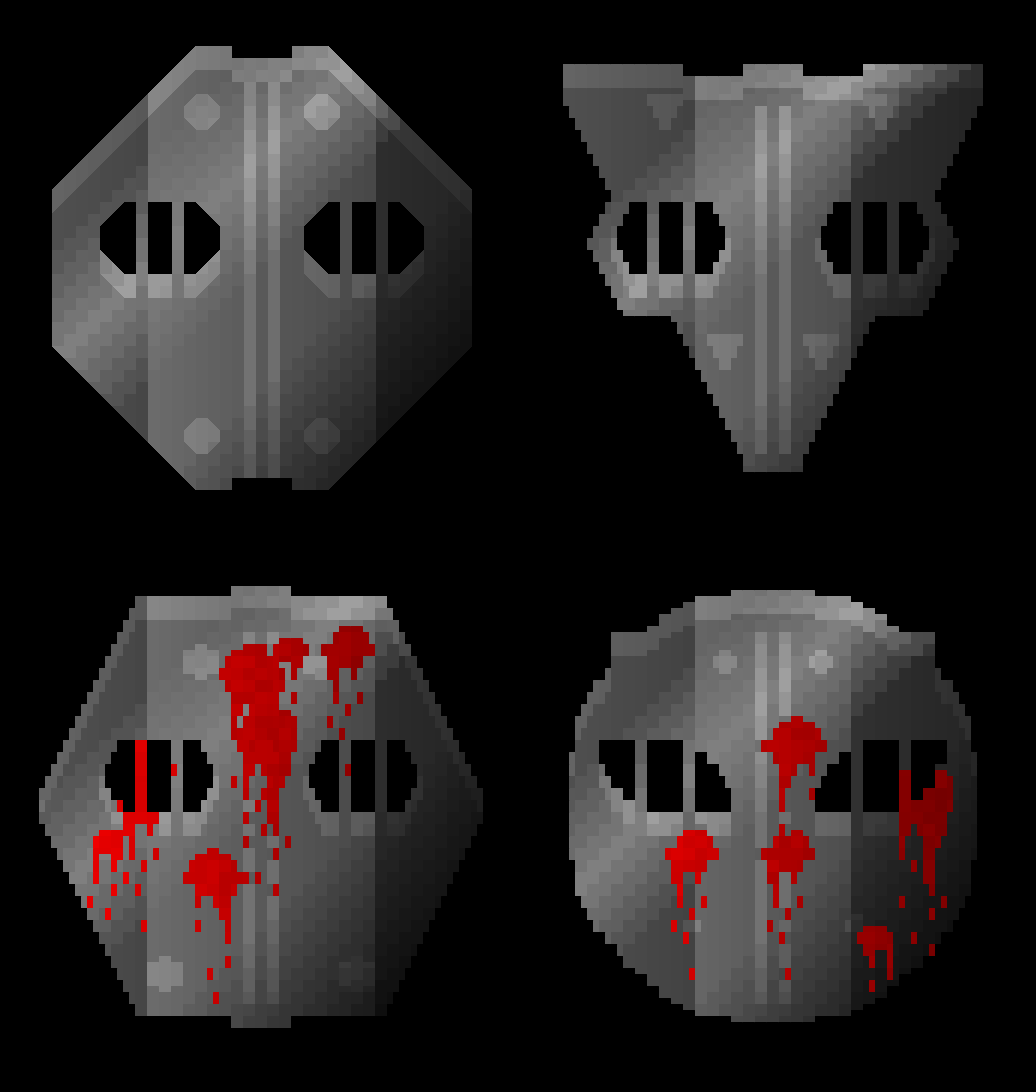
I’ve also added religious masks. The game will choose one religion – it can’t be a “normal” type religion, because I couldn’t make masks look interesting for those, but it can be a religion based on any of the other archetypes (pantheon, Lovecraftian, demonic, animal) – and makes the priests and monks of that religion, and of course inquisitors and things like this later on, wear religiously-specific masks. There’s a whole range of pieces here, and I’m not going to show off the Lovecraftian and the demonic masks – you can find those yourself 🙂 – but I will show off the masks for pantheon religions and the animal religions. The first picture below shows some potential generated masks for a pantheon religion. The game takes the colours for all the gods in that religion, puts those as stripes on the mask, puts a shape in the middle with the number of sides that correlate to the number of gods in that pantheon, and then of course chooses a mask shape dependent on the aesthetic shape preference of the civilization, rather than the religion, in which their mask is being created. Again, very rare as only one religion is chosen to have religion masks, and it could be one of any of the four non-normal archetypes – but I really love these, I think they look very distinctive from the other masks being developed.
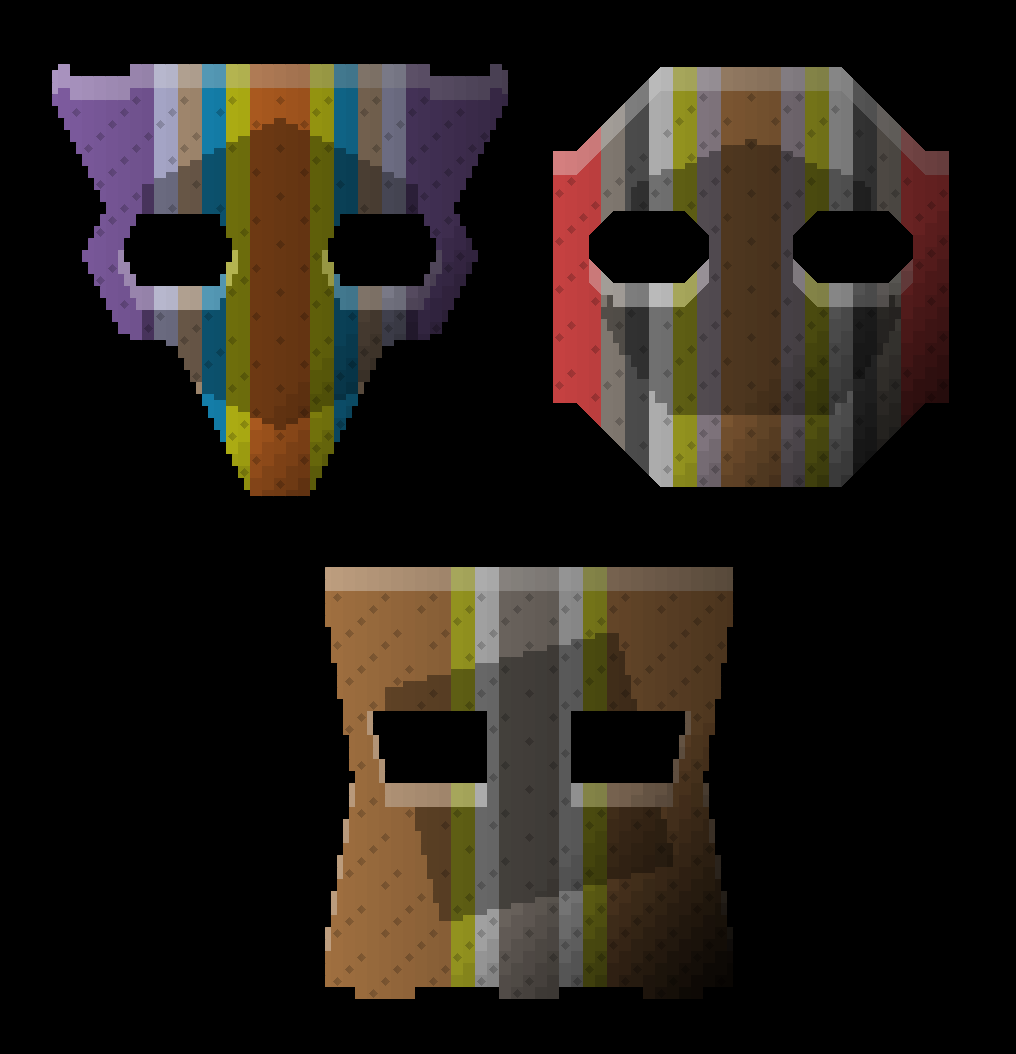
One of these four types is of course the animal god archetype, and here we therefore have a few examples of some animal god masks. Don’t read anything into the fact that all green and blue – that’s just coincidental whilst I was generating a few examples – but rather you will notice that every potential animal god now has a different pattern which can go on its religious mask. The top left one here is for a generated crocodile god, the top right one is for a generated snake god, and the bottom one is for a generated crab god. There’s a couple of dozen potential animals which can be selected for animal gods, and so just as these all have unique statue heads, and unique altar appearances, and many of them have unique hand tattoo patterns, they also have unique mask designs. These were a lot of fun to make, and again they’re going to be very rare – yet still obtainable – items that I think will also help to add some real distinctiveness to some of the religions in the game.
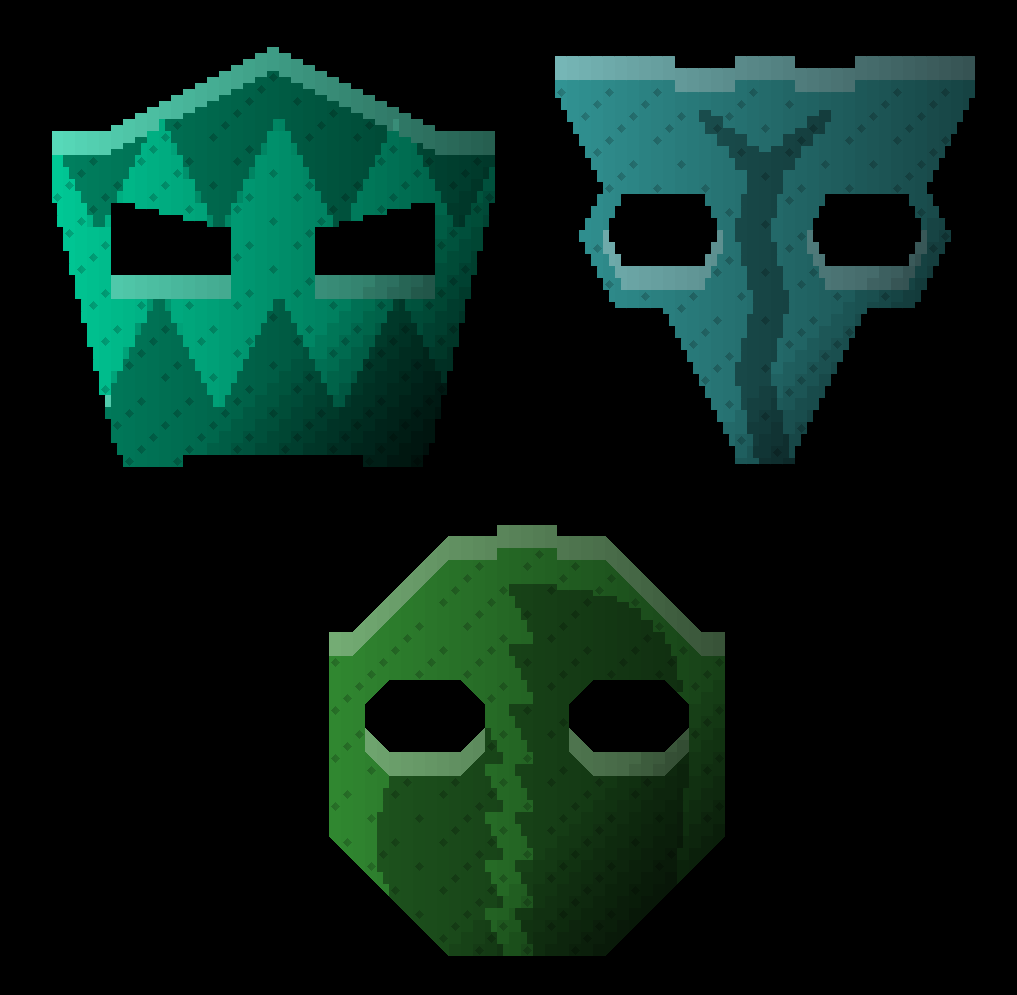
So, to sum all this up – I’m now very happy with masks! All of this was a solid amount of extra work – adding damage into image generators, especially generators which have 3D effects (which pretty much all of them do these days), is a particularly demanding task – but I’m really really happy with how these look. I no longer look at this and think it’s a bit bland and generic, but rather the mask generator always gives the impression of a used item with some history, and has far more depth than was previously the case. The extra variations also bring masks a little bit more into other aspects of the game, while still keeping them distinctive and unusual and rare, and consequential when you encounter them. As part of reworking the conversation system I’ll be adding in many variations for many responses based on whether you or the other person is wearing a mask at that point, but that’s all in the future. For now, this generator no longer feels just a little bit weaker and blander than the quality I’m trying to keep in the game these days, and I love how these look finally. To conclude this part, then, here’s a summation of all the rules and procedure by which masks are assigned:
– One nation wears battlemasks when in combat, chosen from any militaristic nation.
– All nations with the “interventionist” policy have stealthy masks for when doing stealthy, espionage-y things.
– All nations with the “cultist” policy use cultist masks for their various cults, but we can’t have more than one cultist civ who have the same shape preference (and all cults pick a different colour).
– One tribal / ancient nation wears either ice, mud, or bone masks; rarely, a second one will use one of the other two remaining tribal / ancient mask types (i.e. one of ice, mud, bone, that wasn’t selected by the first civ).
– One religion will be selected for all its priests to wear the new religion mask type; cannot be a religion that belongs to a tribal / ancient nation that wears masks, nor a “normal” type religion.
– One nation that either has the penitentiary justice policy, or the ordeal justice policy, will select to use punishment masks on its prisoners / victims, and it will / won’t have blood on it depending on which of the two policies the nation in question has.
And there we have it.
Face statues
Next, a while ago I previously showed off statues with human-type heads, but what became clear is that it is simply too difficult to meaningfully vary how the faces look when you only have around a 9×9 grid of ASCII / ANSI characters to use. Or, rather, they could be varied, but nowhere near enough to reflect the diversity of the actual faces the game can generate when making them at full-size, and not convincingly in the broader art style I’m using. As such, we now also have a head statue model which takes the head of a person and places it on a base. These will be important ways to learn about historical or mythological figures, and enable us to combine textual descriptions of appearance with visual descriptions, which always makes for interesting comparisons. Compared to some other image generators recently, it took a little while to get these looking cool and convincing rather than just looking like a silly chalky head stuck on a stand, but after a good bit of work I’m actually very happy with how they came together. Here are some examples:
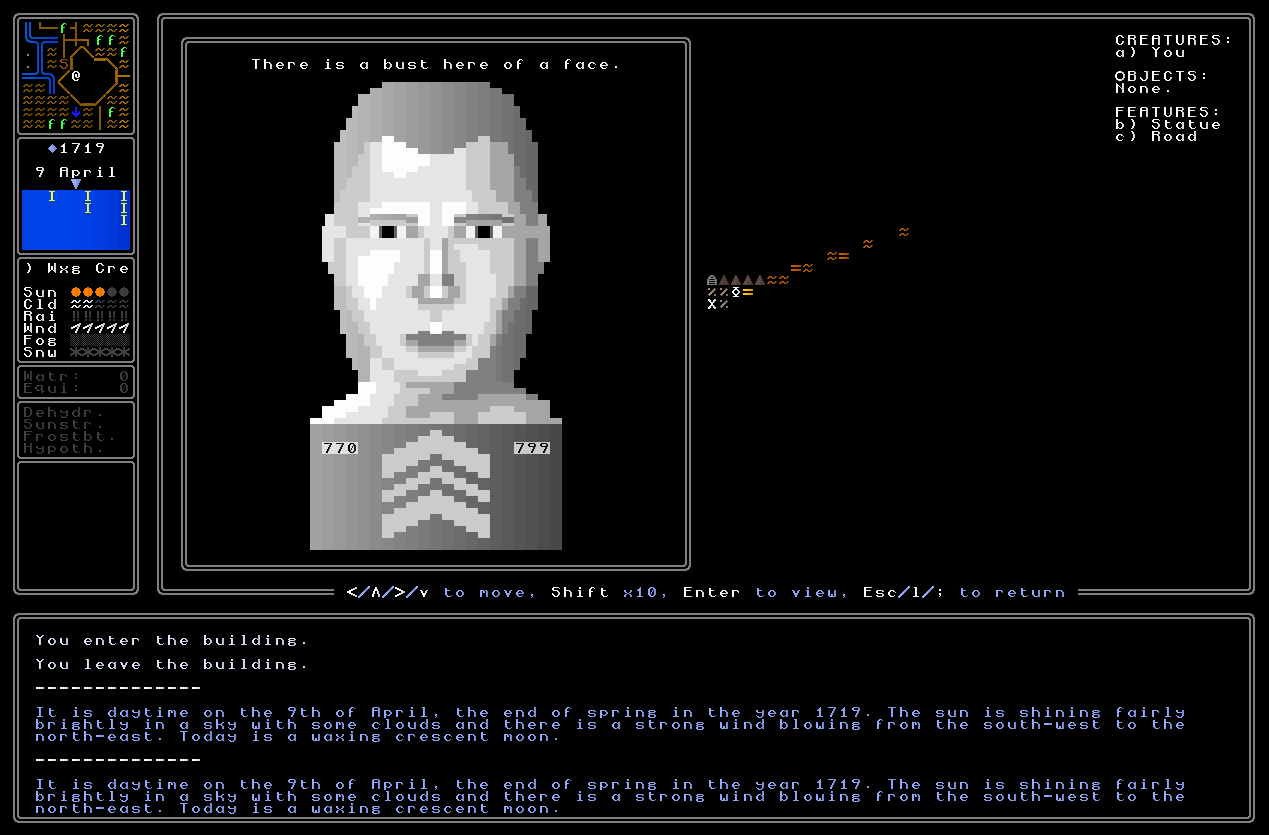
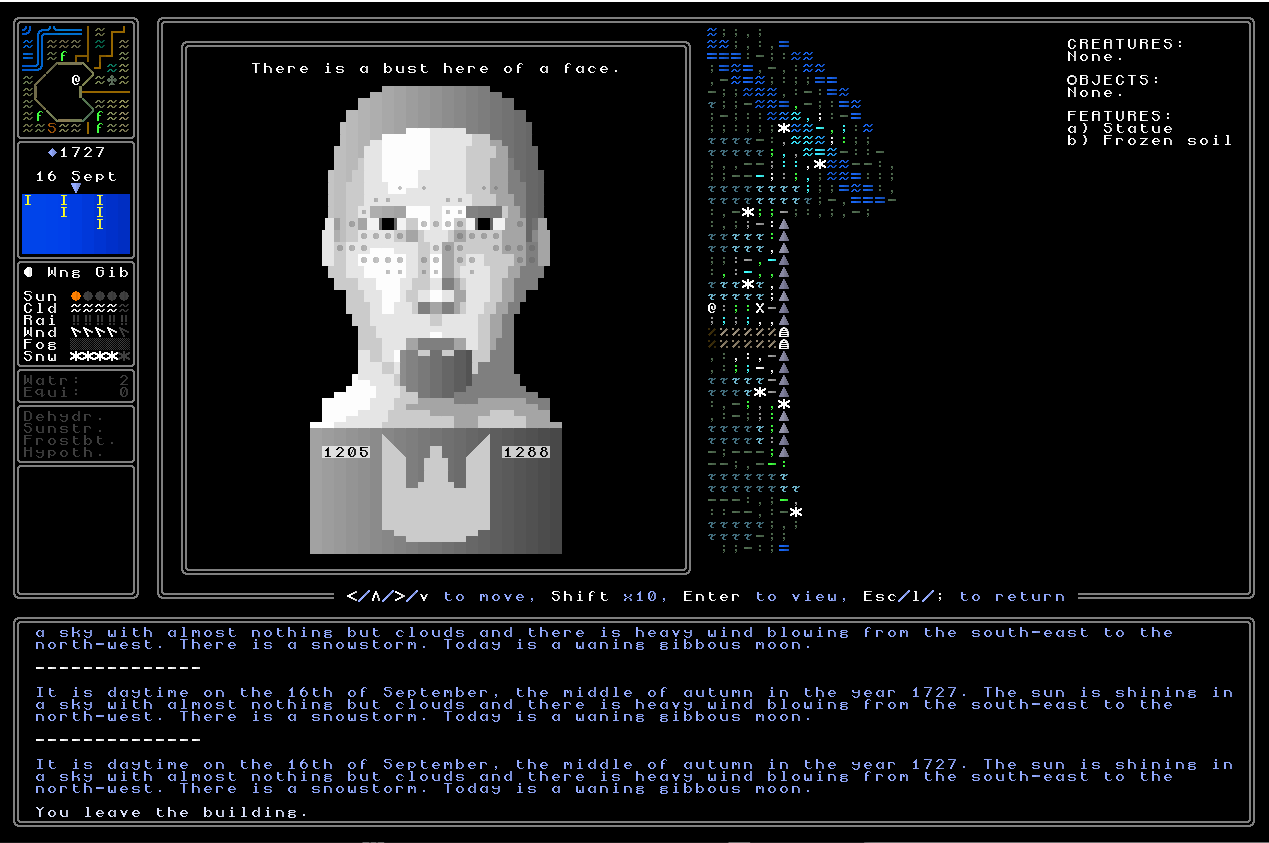
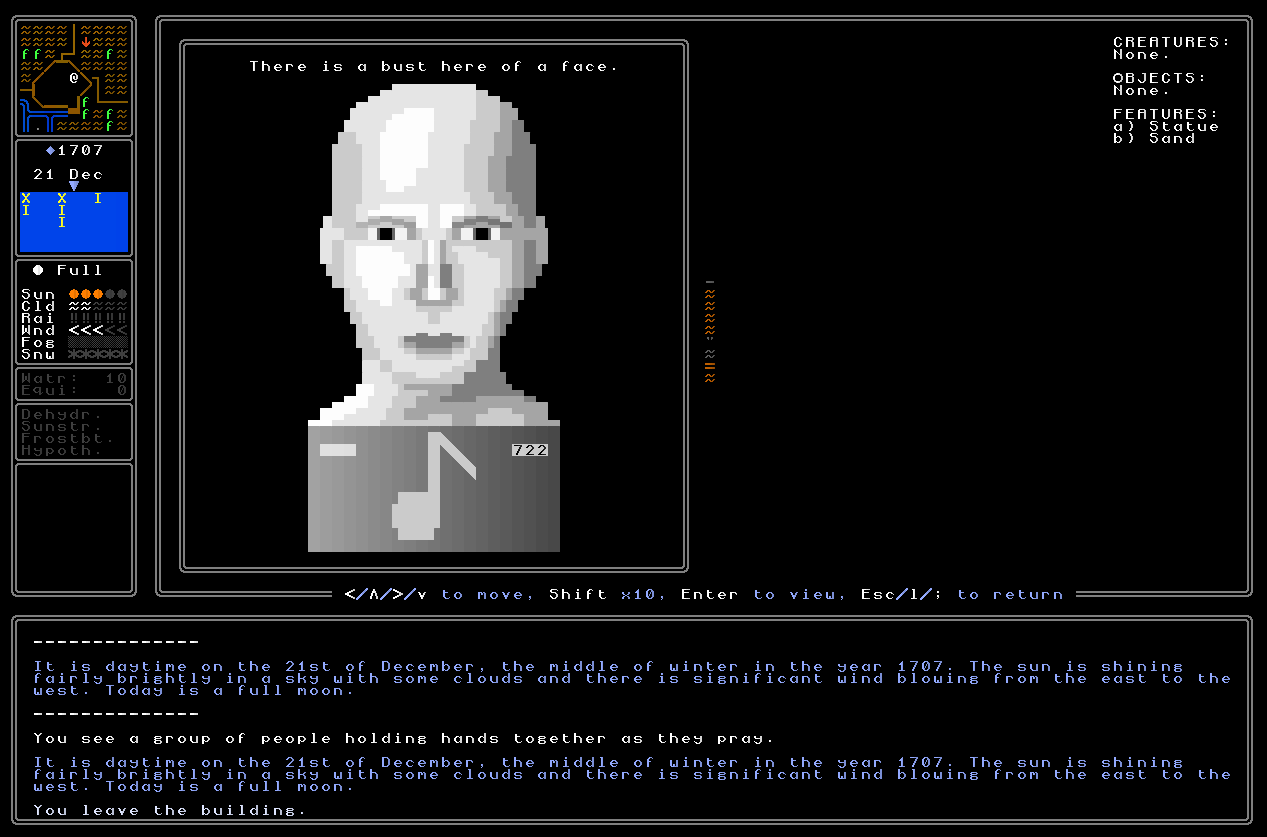
The face will always look correctly like the person’s face (although later maybe I’ll add some historical lies about what someone looks like which also need deciphering…) so if you’re reading about them in a book there should be enough data to deduce who they might be; if it’s a statue of a living person then the face will be a perfect match; and the symbol below will show what they did in life. These are the symbols used on necklaces in nations with the vassalage policy to show rank, and there’s over a hundred of the things I drew (!), so I’m actually really happy I got to reuse them here – the ones here, for instance, are depicting a high-ranking soldier, a monarch, and a musician. You will note that statues will also (normally) show the years of birth and death of the person, if known to whoever created the statue (we’re getting complicated here!), otherwise the birth or death will be shown as a blank space instead of a three-number or four-number year (I had debated having different calendars for each civilization, but I’m not going to do that for years, though I might later end up having generated names for months and days). So essentially each statue has three hints – appearance of the person, the symbol shown below them, and the years shown on each side – with which one might triangulate the statue, along with other data, to figure out who it was. I do like these new statues and I’m excited to integrate them fully with the riddles, the histories, and everything else…
Categorising clues
Finally for this week, I’ve now added a major new facility to all the items you have in your inventory – the ability to categorize them. This is done by pressing Enter when you’re looking at an item. Other item interactions use the number keys, and these can vary from item to item depending on what it can be used to do, but Enter is consistent. This then brings up a little additional window next to the item where you select a character, and the colour, with which you want to code that item. This looks like this:
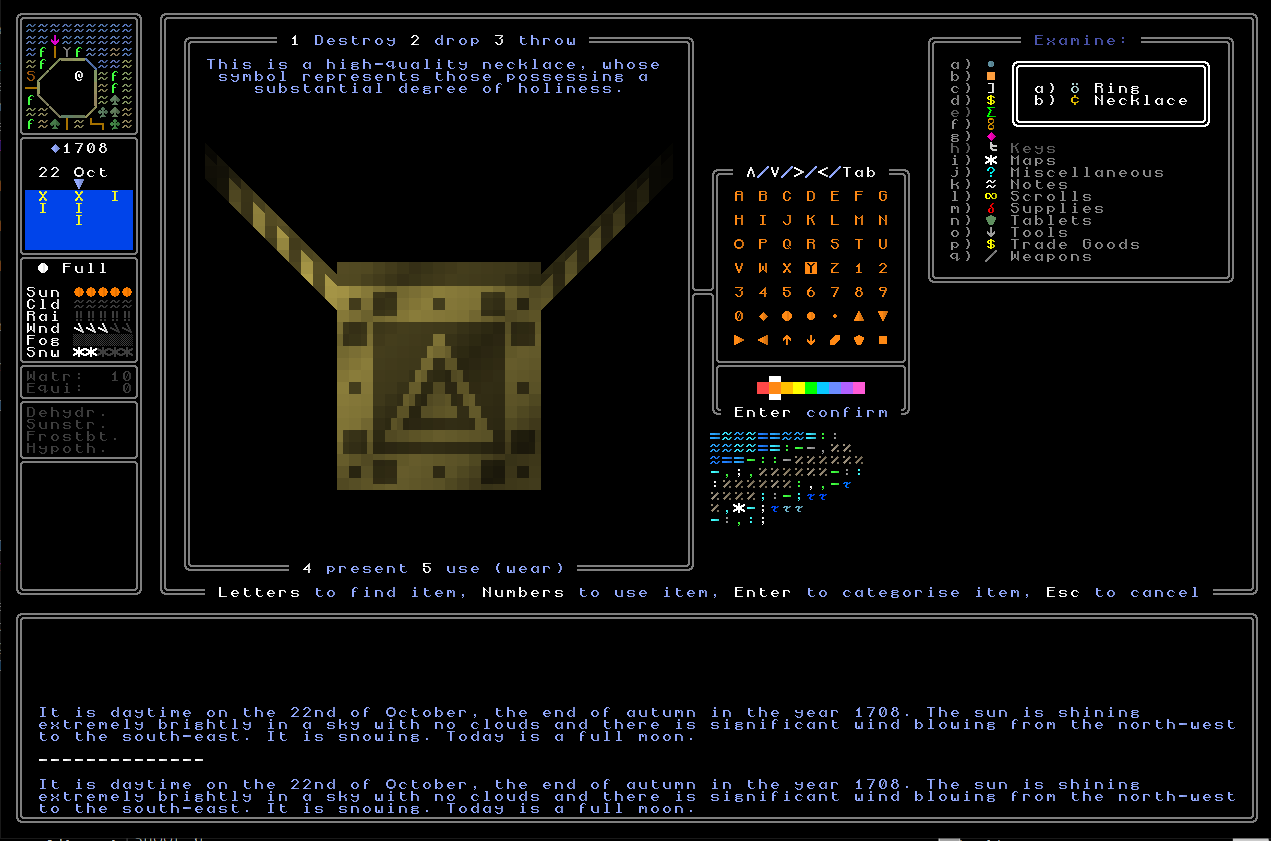
Alternatively, if you already have some codes, it’ll list them for easy recollection:
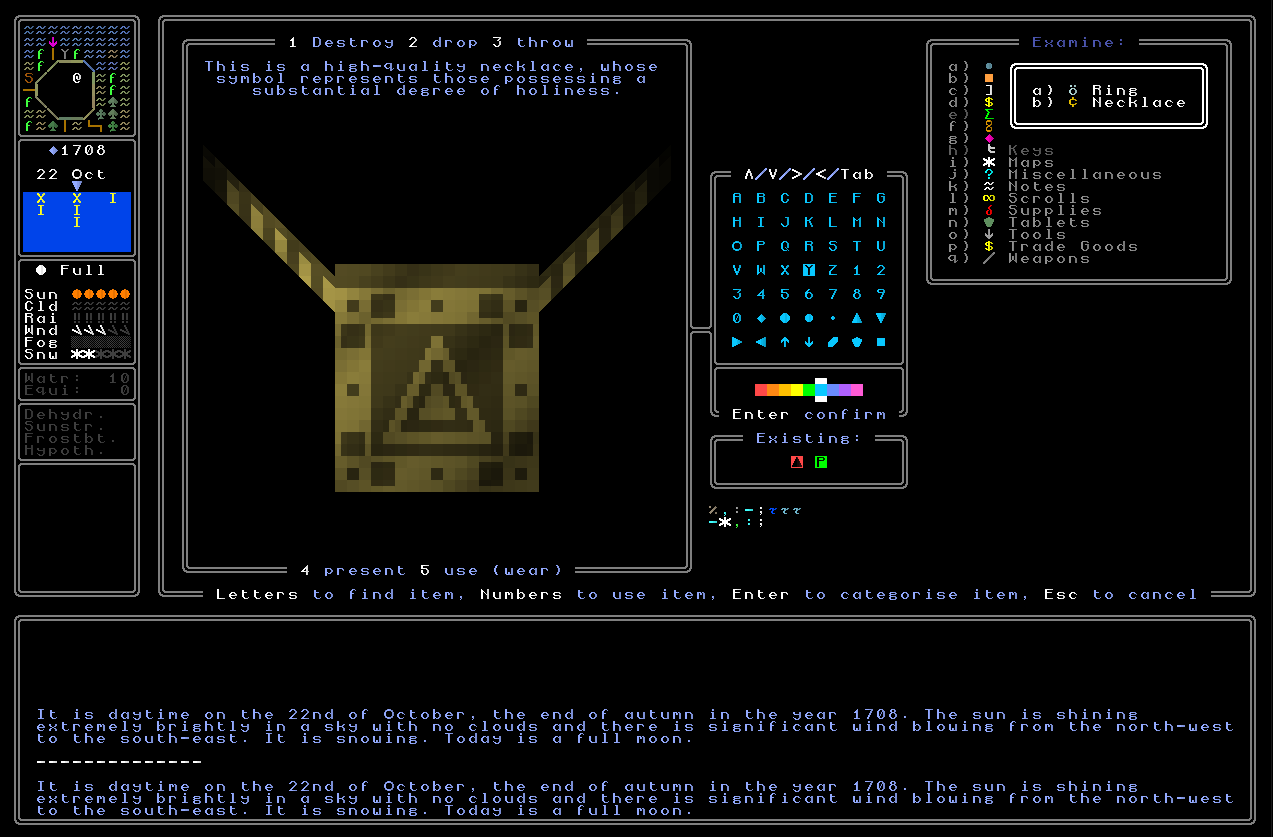
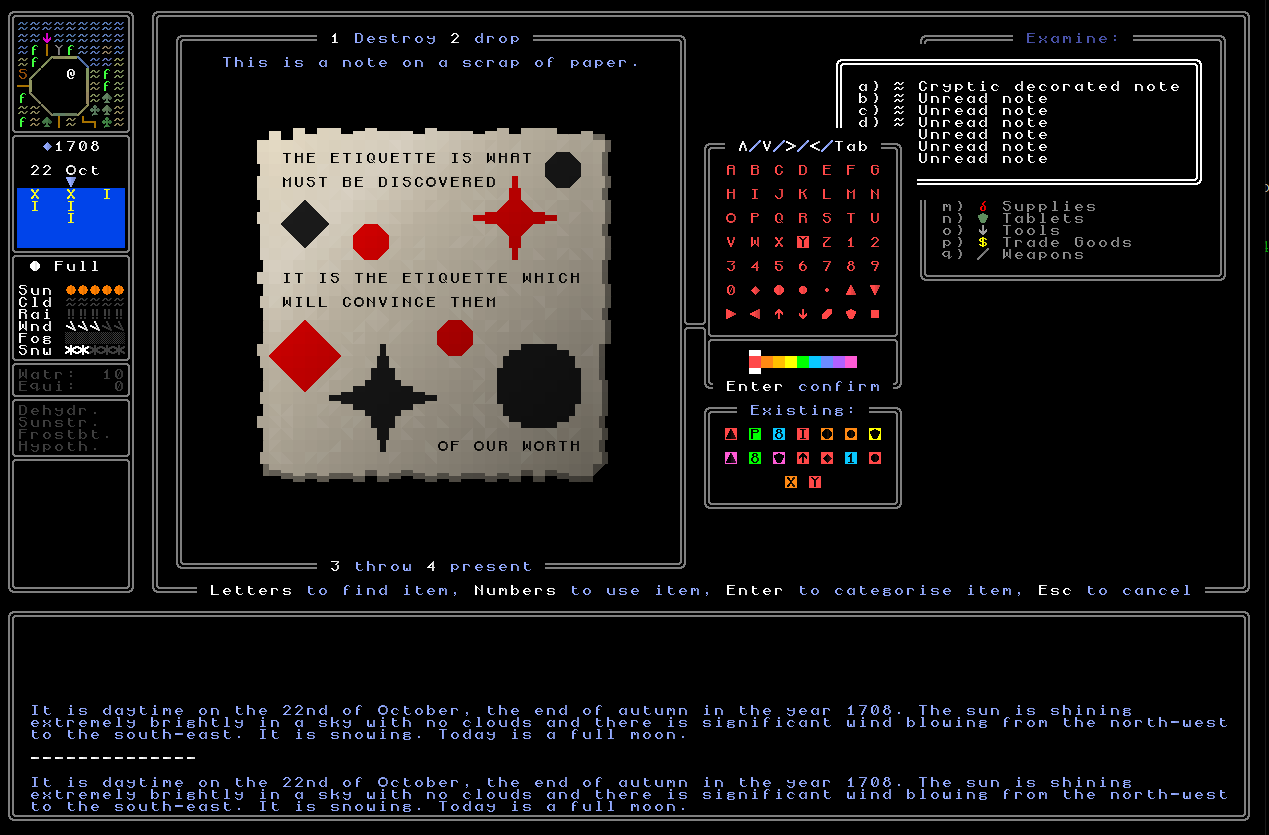
Once you have assigned a code to the item, that item will then show up in your inventory as having that code. As above, there can be multiple codes on a given item – if you aren’t sure what it relates to, but maybe you have a few threads it could be relevant to – and these show up as well. Here are some examples of how coded items might look in your inventory:
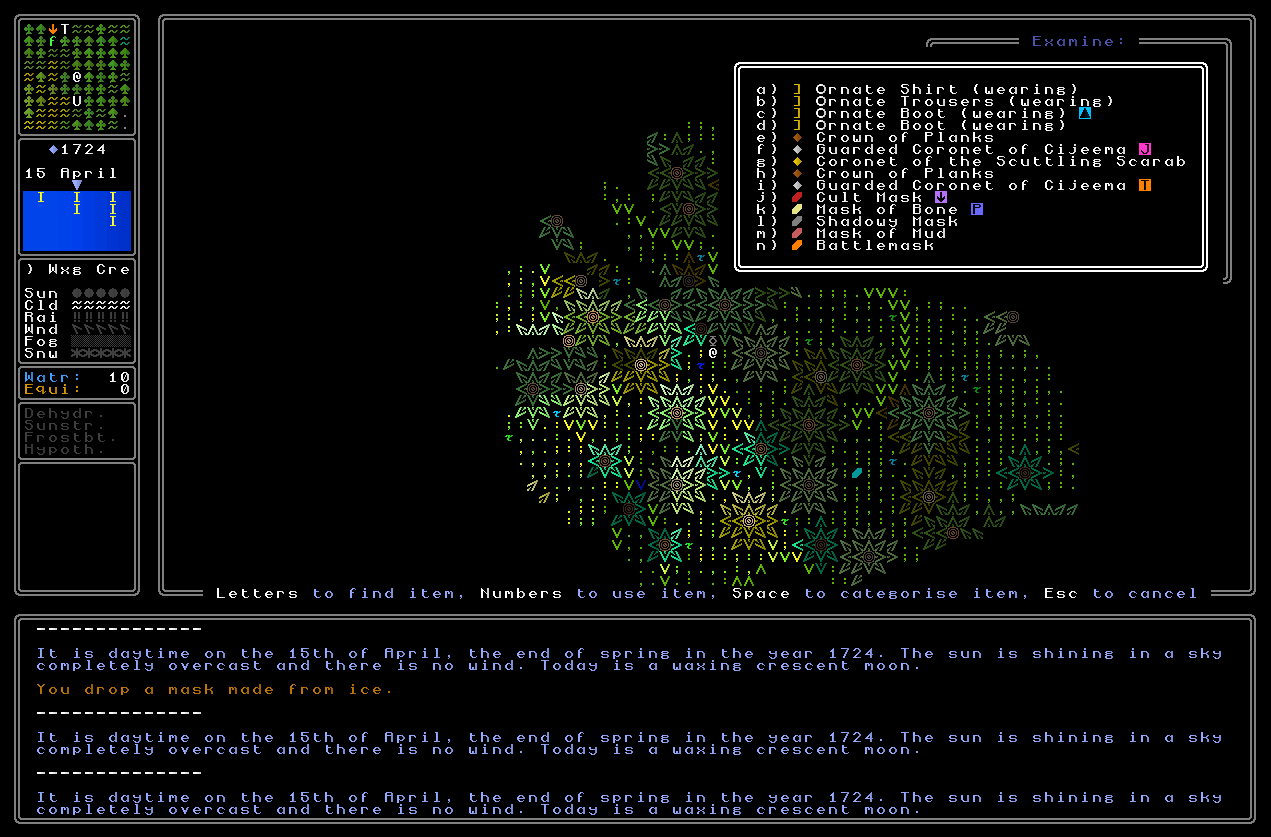
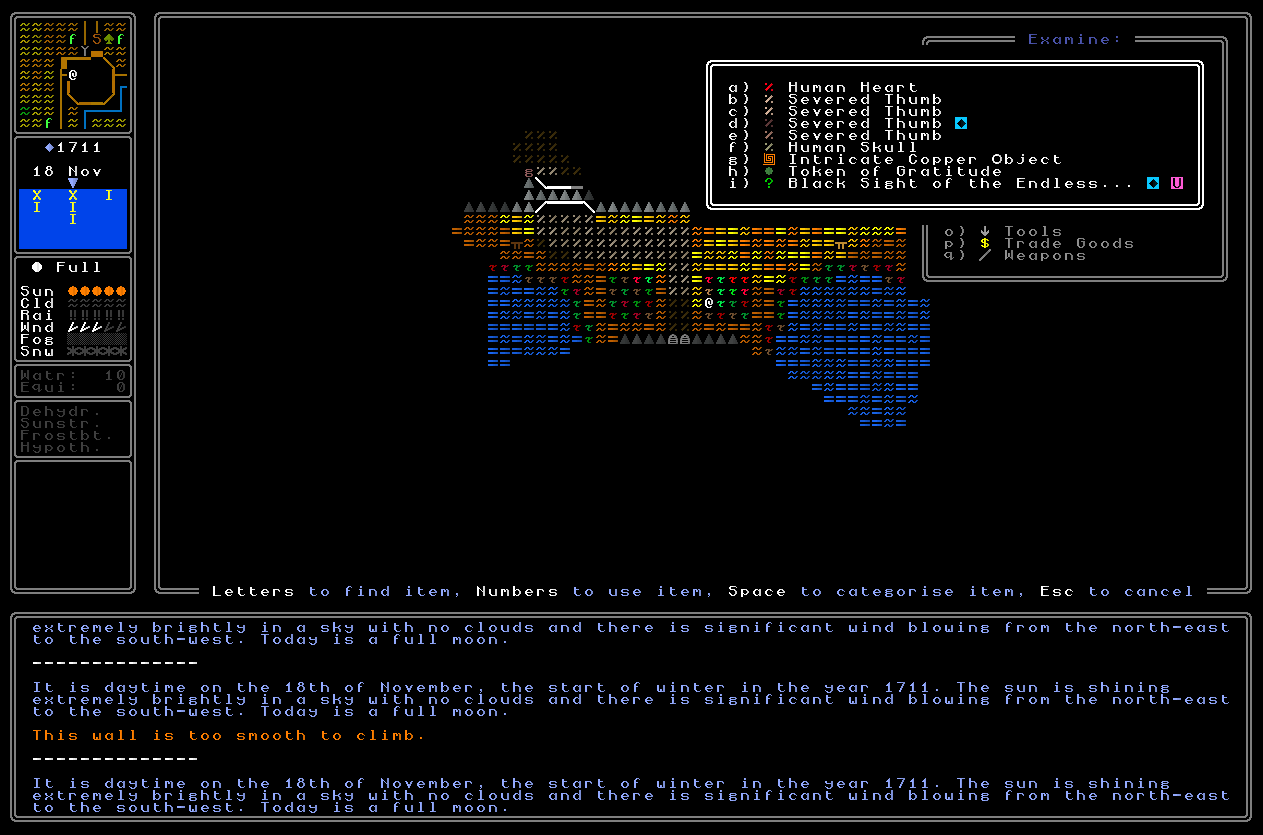
So this is basically designed to be a way to keep track of things without having to resort to pen and paper, or things outside of the game, like Paint or Word. It was tricky thinking through how this would work – I don’t want a system like The Outer Wilds which connects the dots for you (at least to some extent), partly because that would be so difficult in a procedurally generated world, but also because I didn’t want to push the player towards sudden connections or certain interpretations, especially when – I hope – to wind up with riddle threads and complexities that significantly exceed the puzzle depth in The Outer Wilds. However, I also didn’t want the player to have to result resort to things outside of the game if that wasn’t totally necessary, and this seemed like a pretty swift and easy way to code things in a certain way to keep track of what might be connected to what else. As part of this, I will soon add a “clues” screen or something like that, which allows you to sort by your own categorizations instead of anything else, so that you can quickly scroll through all the pieces you’ve marked with a green diamond or a red cross or a blue square or whatever. I think this is a nice little addition though, and I think the little visual codes will be easy for the player to remember, especially as they get to pick the code and decide what makes it appropriate. Looking for clues about a certain king? Well, maybe use “K” and the colour of that nation’s flag. Looking for clues about a certain mountain? Use the up arrow, and maybe green if it’s in temperate land, or orange if it’s in the desert. And so on…
To conclude:
Thanks so much for reading, everyone! That’s this week’s update pretty much done. Universities do still need a little bit more work and polish beyond what I’ve shown in these past two updates (it’s a big thing, so I want to give it the time and care it deserves), but ultimately with them pretty much done, we’re now in the period of working on remaining features and fixes and elements in anticipation of then sitting down and properly beginning the quest generator. That task is very exciting but also quite daunting, and mentally I just need to have as much other stuff for 0.10.3, and 0.11, cleared out of my brain before I really begin to think about it. Continuing to develop universities, finishing off masks, adding face statues, and adding methods to keep track of what items or clues might be connected, are all important elements here which needed adding (both practically, and psychologically), before we get on to the main quest generation.
As ever, if you enjoyed this post, please do think about sharing it around roguelike-y places on the web. I promote the blog posts as much as I can, but there is a limit to the self-promotion which one has time for, or indeed which is morally acceptable! As ever again, please also do leave any comments and feedback in the comment section below, including critiques, which I’m always keen to read, as it’s always good to have my thoughts challenged or pushed in new directions on some of these ideas. The next update will either be another update of this sort – a number of mid-size features being concluded and implemented in anticipation of 0.10.3 and 0.11 – or it will be another major bug-fixing adventure, as those are the two primary things being worked on right now. However, early aspects of the quest and riddle generation system are also being worked on in the background, and these are looking extraordinarily exciting so far – and I’m looking forward to showing those as soon as they’re ready to be shared, which might or might not be sooner than I anticipate. Either way though, the point is – development is rocketing along at pace, thank you all again for reading, I’ll see you all in three weeks! 🙂
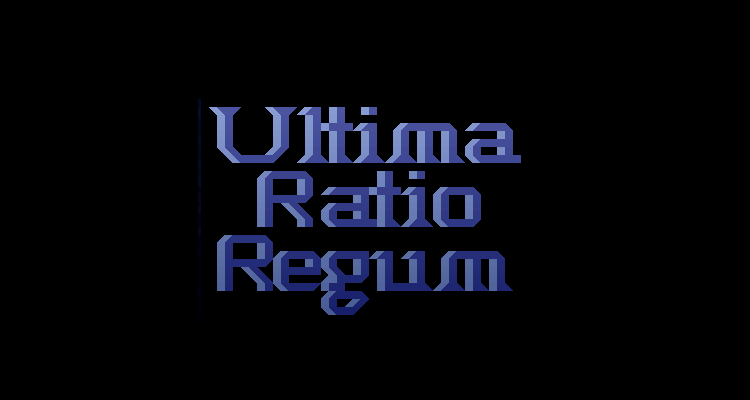
I’m very excited for clue and riddle stuff, keep up the great work!
Thanks so much Greg! 🙂
The museum plinths look very dignified and are also an interesting way to solve the problem of in-game theft by setting plinth as features that can’t be moved into (“Thieves hate this one weird trick!”). And the new masks look great. They might be a useful way to disguise one’s self in a culture or location that uses them, or to infiltrate a specific location. I particularly like the ice masks with the little icicles hanging off of them, and the creepy bloodstained punishment masks.
I’m one of those players that has no problems with (and indeed, enjoys) taking notes outside of the game (I’ve been playing Book of Hours lately and made a spreadsheet with 19 tabs of notes…so far). However, I like the idea of an in-game clue coding & sorting system, which sounds more immersive. This may have been mentioned before, but will the game also include an in-game way for players to write their own notes and/or record images ? i.e., an in-game player journal? Perhaps player notes and images in the journal could also be coded using the new system to help players keep track of their (surely voluminous) pile of notes?
Anyway, thanks as always for the update. I’m amazed at how fast development continues, and I’m excited for quest generation.
Thanks so much for the feedback, crowbar! Yes, definitely, part of the reworking I’m doing now of the conversation system will include a lot of stuff that responds to what you are wearing, as well as the ability for you to comment on what they’re wearing, as well.
Like you, I have no issue with taking external notes, but I’ve watched so many playthroughs on YouTube and Twitch of cryptic riddle games where people often bounce off it, or struggle with noting, if it’s not an in-game thing, and so I do want to put that facility there as well. I guess it’s about just giving the option, even if the player might in fact prefer to do it offline, as it were. And, yes! The player will have infinite paper – as it were – to make a note about anything they see or they think could be important, and as for recording images, that will have the same function – so if you see a mural, you can write a note version of the mural, which will copy what are whatever’s on that mural on to the note. I will add a screen where you can scroll through the in game codings you’ve done, but if I add a journal I think I might add a narrative based journal, which comments on what the player did every day, like “On the 25th of January I left the city of Greenveil, and then travelled in the Nation of Ukkimpo for six days before crossing into the lands of the Traders of the Great Wing. I started to use my supply of water as I crossed the desert…” – and so on. Could be challenging, but also a cool addition, and potentially actually a novel way to introduce puzzles, later in a playthrough, that reference *the player’s past actions*, thereby making the journal actually a source of data…!
Wow. Given the limitations of ASCII, in this case overlaying a ton of information, I’m a huge fan of how clean you’ve kept the interface. The new clue window looks incredible: superb palette and great use of space. Looks aside, it sounds a vital QOL tool for players trying to pull the threads together.
I like the elegance of the plinth solution – can’t walk/can’t pickup. Nice. I am interested how you approach the ownership problem – I feel that could be tricky.
I’m a long time listener, but still get struck by the incredible confluence of visual flair, procedural-coding knack and sociological thought going on here.
Shane, thanks so much for the comment! I really appreciate the feedback, especially as I generally don’t think my QOL / UX stuff to be especially strong (though I am always working on improving them). As for the other thing, ownership in games *is* (as you say) always tough and often leads to some weird outcomes, but I’m confident I can find a good way to handle it – though I confess, I don’t know what that’ll be yet.
And again, thanks so much for the kind words – they *really* are valued very much!
Hello, I was drawn here by the gameplay in “Ultima Ratio Regum” that involves interacting with people. I haven’t officially played the game yet, but I’m about to start and I’m really looking forward to it.
In some world simulation games, NPCs have their own emotions, memories, and daily routines. Personally, I like it when an NPC, if severely offended by me, at least gives me a bad look when I meet them after some time, which would affect the useful information they might provide. This makes me feel that there are interpersonal relationships in this society.
I noticed that in your last update, you mentioned focusing on NPC AI content before the 0.11 releases. I am genuinely happy with this decision. The behavior of people is a reflection of society and culture, and intelligent NPC behavior will make the simulation of society and culture more realistic.
Finally, it would be great if you could answer my question: Could you describe the current state and the ideal future state of NPC AI behavior in “Ultima Ratio Regum” when interacting with players? Does it include mechanisms for interpersonal relationships between the player and NPCs?
Hello Stone, welcome, and thank you so much for the comment! Yes, indeed, I think it’s really important to have that level of NPC variation. Right now URR’s NPCs are pretty detailed compared to most games (roguelike or otherwise), but I’m working on a pretty major overhaul of the whole thing at the moment to add vastly more detail and variation, and far more responsiveness and variability in what NPCs do, what they say, and so on. I won’t be showing off these changes in the next update, nor the one or two after that, but in the near future I’ll have a lot more to say about all this :).
As for the specific question: right now you can ask a lot of questions and get detailed responses which tie into an individual, their society, and their religion. In the future, all that will be true, but also significantly more complicated by situation you’re talking in, clothing and weaponry and armour and jewelry and so on, historical events, previous aspects of that same conversation, previous interactions (if any), your reputation and their reputation, and their ability to ask you questions back, as well as a massively expanded set of questions you can ask them!
Mr. Mark I respect you greatly and I do believe that Ultima Ratio Regum has the potential to become one of the greatest open world videogames ever created *period* but I swear to god if you don’t add the ability to type your own notes into a book I’m going to lose my mind. I need this, Dr. Mark R. Johnson. Please.
(Project Zomboid and Minecraft have cool book writing mechanics so you can write whatever you want and make journals, to-do lists, keep track of what you were doing, etc etc etc. Whatever you want!)
Hahaha, thank you Saint! I… maybe. Maybe! Right now I prefer the idea of being able to note everything within the game’s systems, and having a journal that keeps track of everything you did, but I’m just not sure I think writing your own notes, outside of note-taking and clue-categorizing systems, is required. I’m not committed to this position though! We’ll see!
Very nicely done masks. Reminds me of Seguleh nation from Malazan empire.
Their masks were pretty much the same, but the distinction was made by the drawings on them. That marked your status in the civilization.
As cool as they sound, they are best when not overused. It seems you know that, as you wrote, they will be very rare. However I would go even further and not guarantee they will occur in each instance of the world creation.
Few more appliances from our world:
– art – artistic coupe that is performing on scene (e.g. to portray different sex),
– hiding imperfections – remnants of diseases such as leprosy, scars,
– incognito – good quality mask that try to mimic someone else visuals,
– psychopath – e.g. flesh torn from a victim face.
Anyhow, very nice update again. Cheers
Thank you so much for the comment, neobit! You have actually nailed my inspiration perfectly (currently in the middle of reading them for the first time, and just finished The Bonehunters). I also hear you on the rarity point, and I may well indeed limit them further – we’ll have to see how it goes. I love the additional suggestions too, thank you! The art one particularly stands out to me. I am planning on generating theatres (and plays!) a bit later on, so that could be a nice addition to go in there, perhaps. The disease mask is also super interesting and I can see how that would work as well. I shall ponder!
Super nice, that is my favorite fantasy creation. I’m rereading it now from the beginning, after reading all (all!) of the books Erikson and Esslemont made. Currently, at Memories of Ice. Hope you continue to have fun with it.
You have a great source of inspiration and I have to admit you are doing it well. So far, it feels like the same level of epicness. Keep up the good work!
Amazing! I’m not yet sure whether I’ll check out the others beyond the core series; Bonehunters was only book so far in the series that I struggled with (I liked 1, and loved 2/3/4/5), though it really picked up at the last 1/4 (the opening 1/4 was also strong, but that middle 1/2 was hard going). We’ll have to see how I feel after #10… (and thank you!)